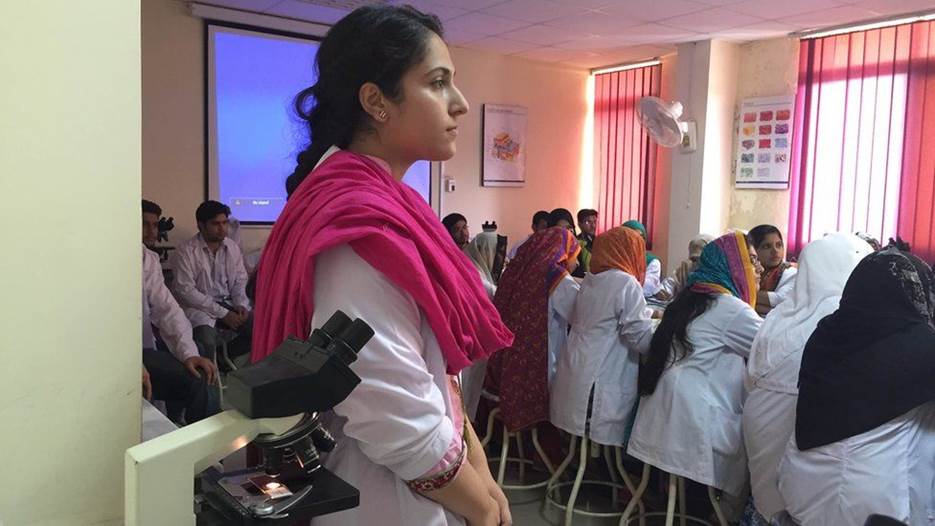.

Practicing doctors or wives? Dilemma for Pakistan’s female medical students – BBC News
Wasted Talent
By Zubeida Mustafa
Karachi, Pakistan
There used to be a time when ‘tea trolley’ (borrowed from the title of Rehana Alam’s book) marriages were arranged by the families of prospective couples. It was not uncommon for those who were about to tie the nuptial knot to be strangers to one another; it followed that they had no say in the matter of their own marriage. In fact, this cultural practice still persists in many households.
Today, we are faced with a bizarre situation: girls outnumber boys in medical colleges — 70 per cent are girls — but half the number do not enter the medical profession after graduation and opt for the stereotypical role of a homemaker assigned to them by a patriarchal society. This also happens to be a time when there is an acute shortage of doctors in the country.
It seems to pose an ethical dilemma since the common belief is that female medical graduates who do not work are not interested in doing a job, and that they join medical college to enhance their worth in the marriage market. As a result, they encounter public disapproval as the general opinion is that they should pay society back the benefit they had received from the subsidized education offered in public medical colleges.
I decided to visit Dr Farhat Moazam, professor and founding chairperson of the Centre for Biomedical Ethics and Culture, Sindh Institute of Urology and Transplantation. Founded in 2004, it is now a WHO-designated bioethics center. Under Dr Moazam, who won the Hastings Centre Bioethics Founders’ Award in 2022, CBEC has conducted master’s and post-graduate diploma programs and certificate courses for hundreds of participants. Her qualitative research on Pakistani medical students (co-authored with Sualeha Shekhani) has been published in the journal Medical Education (UK).
Dr Moazam began by saying it is most unfair to blame the female students because it is our patriarchal society which creates this situation. No support is forthcoming to the young female doctors. Our medical training system is inadequate, substandard and the trainees are poorly paid.
Marriage is central to our societal values. The girls who participated in interviews and focused group discussions conducted by Dr Moazam also conceded that marriage was their preference although it left them little control over their lives. Thereafter, they had to accept the role assigned to them of the homemaker and mother.
In the absence of support from family and society — few institutions provide for day-care centers for young children of working mothers — female medical graduates simply don’t work. A hospital job is, after all, tough and time-consuming. No girl can handle a medical job, her home and her baby single-handedly. Dr Moazam also points to the poor training facilities and their insufficient numbers in teaching hospitals.
The CPSP only conducts specialization examinations. As for the stipends, they are not enough to support a family. If all the students who pass their MBBS were to decide to seek training, large numbers would be turned back. As a matter of fact, many male medical graduates are also known to be dropping out for this reason. Another significant finding of the CBEC research is that the number of male applicants to medical colleges is falling. Men do not find the medical profession financially satisfying in the early years.
Then what is the solution to this challenge? Dr Moazam suggests changes to the medical training system. There is a need to enhance the capacity of the teaching hospitals so that no young doctor is denied the training which is a prerequisite for the CPSP exams. The standard of training should be upgraded, and the emoluments increased so that young doctors get decent wages. Every institution where women work should be required to have a childcare center on its premises.
A proposal worth trying out is to have a number of shared jobs, which means one job should have two women working for the position on a part-time basis. This would reduce the number of hours a woman is required to work every day though it will take them longer to obtain their degree requirement. All this is possible if the authorities are serious about finding a solution to the problem of the shortage of doctors. Dr Moazam insists that more research is needed on these issues to ensure that the changes introduced are meaningful and feasible.
Underpinning these reforms should be a change in the general mindset. Only then will the family step in to facilitate a young doctor who wants to work. It would also ensure stability in the life of the working mother’s child. -
www.zubeida-mustafa.com

